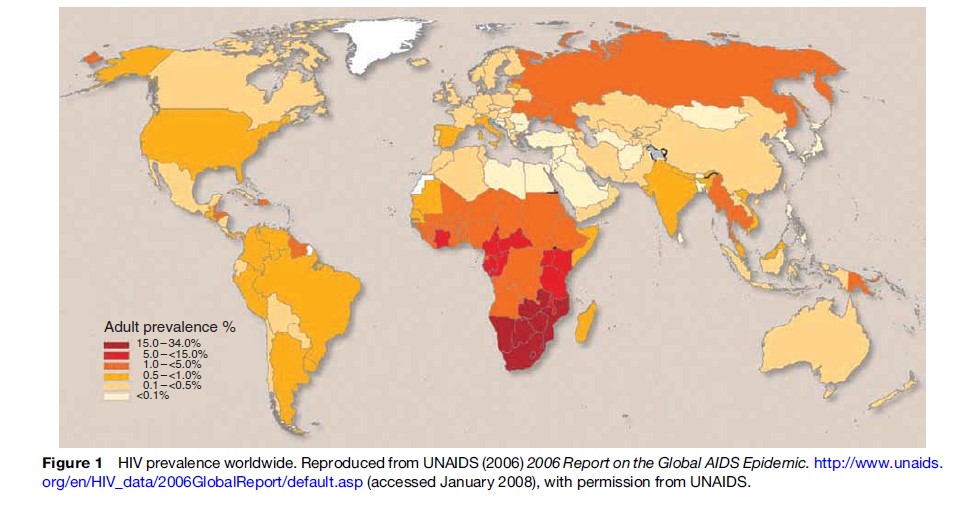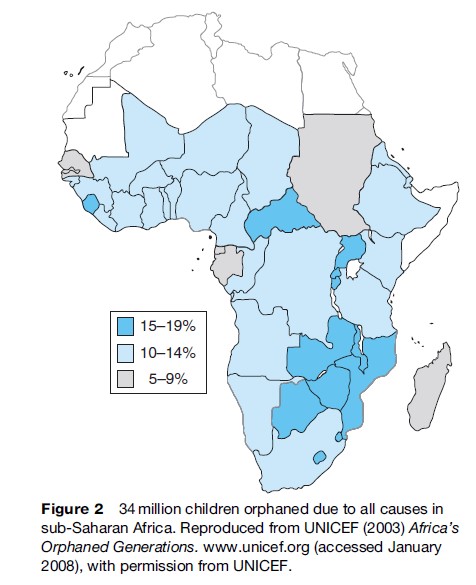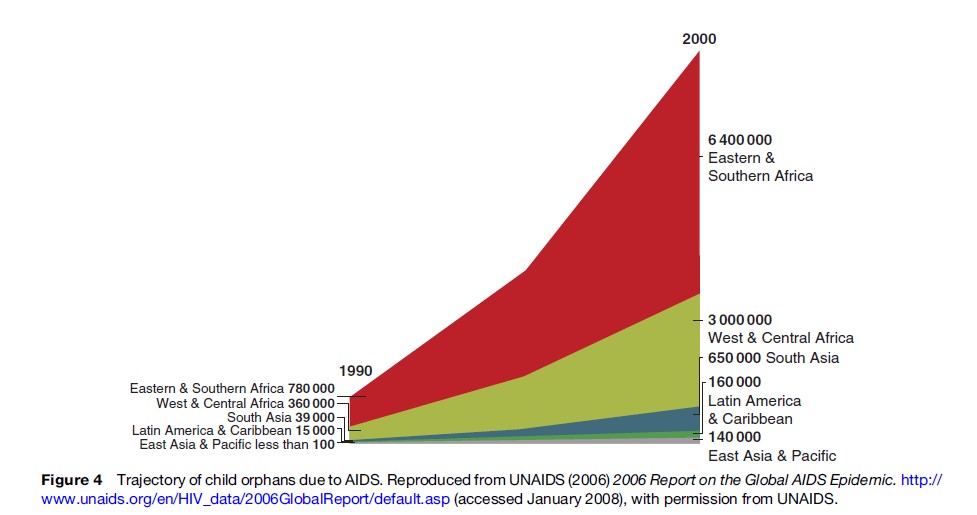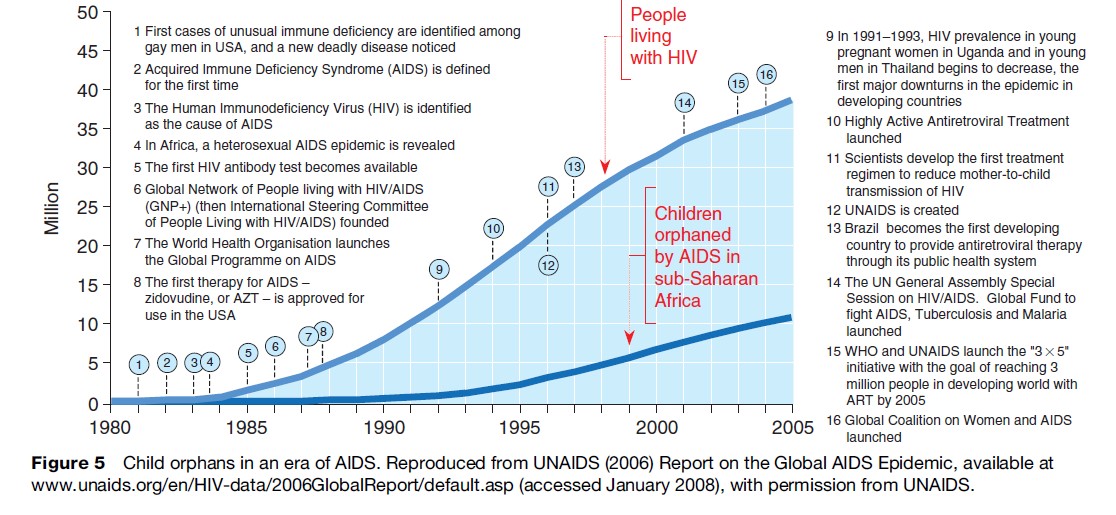Patterns of illness, human rights abuses, and orphanhood that characterize the global HIV/AIDS pandemic are not forged by chance. Rather, poverty and economic inequities, the absence of educational opportunities, exploitative child labor, and pervasive violations of women’s and children’s rights produce the patterns of human suffering that are the subject of this research paper. A multitude of problems challenge children who are orphaned as a consequence of HIV/AIDS. While the problem of AIDS and orphans is most acutely experienced in sub-Saharan Africa, analysis of the patterns of suffering and their sources there may yield insights critical for devising effective public health strategies to alleviate both local and global suffering caused by the HIV/AIDS pandemic in other countries.
As of 2006, an estimated 39.5 million people are living with HIV, approximately 4.3 million are newly infected, and 2.9 million died in 2006 (see Figure 1). While HIV prevalence has leveled off in some countries, it is increasing at rates that far surpass initial predictions in others; thus, the overall number of people living with HIV is increasing. The pandemic has generated increased morbidity and a precipitous fall in life expectancy and birth rates, which has significant ramifications for child, community, and country development.

On average, almost one in three pregnant women receiving care at antenatal clinics in southern Africa is HIV infected. Young women aged 15–24 are two to six times more likely to be infected than men of the same age. In spite of the advances in treatment access, only 20% of people with advanced disease (1.3 million) are receiving needed antiretroviral treatment. Best estimates state that the median lifespan of HIV-infected women is 9 years. Maternal death has profound implications for infants, children, and adolescents; infants and young children in particular are at increased risk of dying.
Problems such as war, famine, and infectious disease outbreaks have produced large numbers of orphaned children. However, orphanhood is becoming a chronic condition of childhood with ramifications for adulthood because of the magnitude, morbidity, and mortality of the HIV/AIDS epidemic. Nowhere is this chronic condition more apparent than in sub-Saharan Africa, home to 24 of the 25 countries with the highest HIV prevalence rates globally.
Prevalence Of Orphaned And Vulnerable Children
A commonly used definition of ‘orphan’ is a child whose parents died before the child reached the age of 15. However, there are problems with this definition. Adolescents beyond 15 years of age have needs and require adult support. A definition of child orphans that used the language of the United Nations Convention on the Rights of the Child, which defines a child as anyone 18 years of age or less, would include this vulnerable population of 15 to 18-year-olds. There are cultural nuances in the use of the term ‘child orphan.’ For example, in some African countries, an orphan is a destitute child, regardless of whether he or she has a mother or father or both who have died. Finally, there is the issue of who is counted as a child orphan. Some agencies and studies only count orphans as children who have lost their mothers (i.e., maternal orphans), not their fathers (i.e., paternal orphans). However, some researchers would argue that maternal orphans become virtual double orphans (i.e., those who have lost both parents) because some fathers in this situation, while not dead, are not present and actively contributing to the care of the children.
In spite of these shortcomings, the above definition is the most commonly used. Without HIV/AIDS, the number of double orphans would have declined from 1990–2010. Instead, it will triple. As of 2003, an estimated 15 million children under 18 years of age have been orphaned by HIV/AIDS worldwide, and 12 million of these live in sub-Saharan Africa (see Figure 2). In comparison, there are 320 000 orphans in the United States. Overall, 9% of children in sub-Saharan Africa have lost at least one parent to AIDS; however, in Zambia and Swaziland, 25% and 35% of children, respectively, have lost at least one parent. Orphanhood due to HIV/AIDS is accounting for a greater proportion of all orphans worldwide. In 2001, 32% of all orphans in sub-Saharan Africa lost their parents to HIV; this has increased to 50%. In 11 countries in sub-Saharan Africa, 75% of parental deaths are due to AIDS. Another disconcerting phenomenon is the estimated ten-year or longer time lag between peak HIV prevalence and peak orphanhood. Thus, even when HIV rates stabilize or decline, the numbers of orphans will continue to rise for at least a decade.

In four countries outside sub-Saharan Africa, orphan prevalence is greater than 10%: Haiti, Afghanistan, Lao People’s Democratic Republic, and Democratic People’s Republic of Korea. However, unreliable or nonexistent data from these and other countries prevents accurate estimates of the number of orphans due to AIDS.
Surveys suggest that overall approximately 15% of orphans are 0–4 years old, 35% are 5–9 years old, and 50% are 10–14 years old (see Figure 3). Each one of these age groups faces unique risks to their health and well-being. Double orphans are more at risk than single orphans. And HIV-infected children who are orphaned suffer the double burden of being afflicted with the same illness that claimed the life of one or both of their parents.

Although there are many problems with current models of measuring the scope of orphan prevalence, it is known that the relationship between HIV prevalence, orphan prevalence, and effects on family, community, and societal structures will change as the pandemic progresses. If rates of infection continue at their current pace, the prediction is that there will be 20 million orphans due to AIDS in Africa by 2010 (see Figures 4 and 5). The number of double orphans is expected to account for half of these. According to UNICEF, in light of current trends, the countries that will have the highest proportion of child orphans will be Lesotho, Swaziland, Botswana, and Zimbabwe, and greater than 80% of these children will be orphaned as a consequence of AIDS.


Vulnerabilities Of Orphaned Children
One of the first vulnerabilities that children face is whether they will be cared for, and by whom (e.g., other adults or children). A study of families in Zimbabwe found that important factors in the decision to care for orphans were social relatedness and financial capacity. Caregivers were more open to fostering children if the child was a relative (75%) rather than a friend’s child (50%) or a stranger’s child (25%). Data from UNICEF demonstrate that the majority of AIDS orphans (90%) are being cared for by extended families (e.g., grandparents, aunts, uncles). Currently in sub-Saharan Africa, 1 in 5 households with children care for at least one orphan.
Another issue is the quality of care, both material and psychological, that child orphans receive.
In addition to not being the healthiest option for children, placement in orphanages is not culturally appropriate or financially feasible in many countries (in some countries, orphanages do not exist). For example, Zimbabwe has 800 000 orphans, and less than 4000 are housed in 45 residential centers. But the reality is that many families, especially those headed by grandparents who are no longer economically active, are financially destitute. Household out-of-pocket spending is the largest single component of HIV/AIDS expenditure in Africa, greater than the amount of money contributed by governments and nongovernmental organizations.
AIDS is causing a deepening of poverty that affects all children, regardless of age. Child orphans are more likely to live in large, female-headed households with little income. In some households with at least one HIV-positive person, the income is half of similarly sized households in which HIV is not present. Some HIV-affected households spend up to four times more money on health care and use 30% of their income on funerals, while food consumption decreases as much as 40%. For infants, this poses a grave risk for malnutrition and accompanying acute morbidity and mortality. Recent studies have shown that children under 5 years of age living with an HIV-positive mother have higher mortality rates one year prior to and one year after the death of the mother, even after controlling for potential perinatal transmission. For households with orphans, there is an increased ‘dependency ratio’; in other words, fewer people are economically active in the face of a greater number of household members.
Children possess unique psychological and emotional needs. With the loss of biological parents comes a disruption in the parent–child relationship. And even though a family may take in a child, he or she may be forever viewed as an outsider and less valued than the other members of the family. Some children may have family members who help them through their bereavement. But it is also quite possible that family members are so consumed with finding food, clothing, and shelter that they do not have sufficient time to help children or adolescents who may be struggling emotionally. Adolescent orphans demonstrate heightened anxiety and higher rates of depression and anger than their non-orphaned counterparts. For some children, their bereavement is increased because they have been separated from their siblings. In addition, children face stigma and discrimination because they are assumed to be infected. Younger children in particular, who may not understand the disease process, suffer the loss of friendships, and are at risk of physical, verbal, and psychological abuse. Stigma, in many contexts, perpetuates the epidemic and results in more affected children.
Rapid disintegration of their family can leave children at a loss regarding how to function in the world. In Africa in particular, a child’s social, spiritual, and moral development and ultimate place in society are determined in large part by the family and kin. Disintegration of families results in disintegration of social capital (social relationships that facilitate community action for the mutual benefit of members) within communities.
For older children, the risk of death is much less than infants, but the risk of not receiving a formal education is quite high. In some cases, the teachers are ill or caring for ill relatives and thus are unable to teach; this affects all children, orphaned or not. Or the family caring for the orphaned child cannot afford to send that child to school. In the case of adolescents, they may be required to care for relatives and siblings or find work to support the family, and thus must forego education. Currently only 64% of children in Africa and 83% in Asia are enrolled in primary schooling. Given current trends of increasing numbers of orphans, it is likely that fewer children will attend school. For those who are able to attend school, the challenges do not abate. A study of five countries in sub-Saharan Africa found that children who had lost one or both parents were significantly less likely to be in the appropriate grade for their age. Knowing what a critical role early child development and literacy play as social determinants of health, lack of schooling will result in worsening overall health for these children and adolescents.
A child less than 18 years old heads approximately 1% of households. However, orphans living alone or in youth-headed households are becoming more common. A study in Zimbabwe found 5% of caregivers were in their teens. In some cases, they may still have contact and receive support from relatives, but in other cases, the opposite is true, and youth feel isolated, marginalized, and rejected. Adolescents are sometimes expected to assume the role of parents, but without the requisite rights given to adults. In the face of inaccessible, overburdened, underdeveloped judicial systems that do not recognize child rights, they are at risk of losing their inheritance and property. Adolescent orphans initiate sex earlier than non-orphans, thereby putting themselves at risk for pregnancy and sexually transmitted diseases.
Given the dire economic situation that many families face, children are expected to start working, many times in unjust, dignity-impugning labor. An International Labor Organization (ILO) study in Tanzania found that 70% of self-employed children, 60% of child domestic workers, and 55% of child sex trade workers lost parents to AIDS. A study in Zambia revealed that the average age of children engaged in sex work was 15 years. Three-quarters of these young people had lost one or both parents to HIV/AIDS. They said they engaged in prostitution because they and their families needed money. There are no clear estimates on the number of children living on the street as a consequence of being orphaned. However, one study in Zambia demonstrated that 58% were due to loss of parents. Children become the victims of popular myths regarding HIV prevention (e.g., that an HIV-positive man can cure himself by having sexual intercourse with a young virgin) and face sexual exploitation, with its concomitant risks of pregnancy and sexually transmitted diseases, including HIV.
